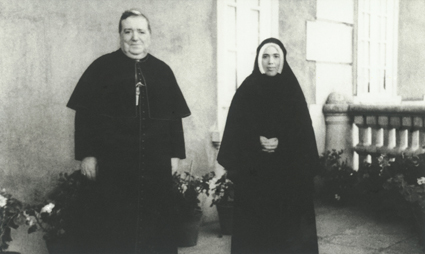

Sister Lucia with Bishop da Silva in 1946
This kind of topic is rather unsavory in itself, as it invokes memories of silly conspiracy theories, including one, some years ago, that featured photo enlargements of the ears of Paul VI. It would not be worth mentioning in this Series, were it not for the fact that some rather serious-minded sources are suggesting that the Vatican II Era Sr. Lucia was not the same person as Pre-Vatican II Era Sr. Lucia. The theory, if it were true, would explain a lot of difficulties encountered by those who believe the entire Third Secret of Fatima has not yet been divulged publicly. It would explain why Sr. Lucia apparently never complained about this. It would explain the absurd "confession" which Sr. Lucia was supposed to have made about the "1960 date." It would explain why the Vatican II Era Sr. Lucia seemed so carefree and lighthearted, while the Pre-Vatican II Era Sr. Lucia was always seen to be so grave and concerned. But therein lies the danger—one might give too much credence to the evidence out of a sense of preference, rather than on its merits. One might prefer to believe it, and therefore assume too much.
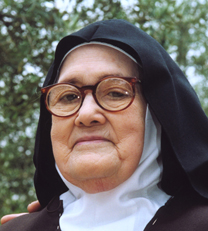
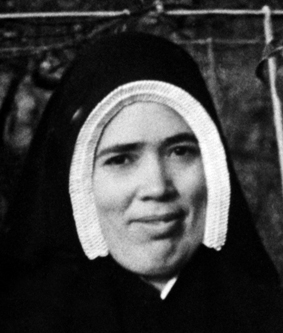
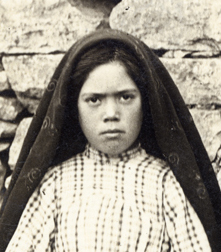
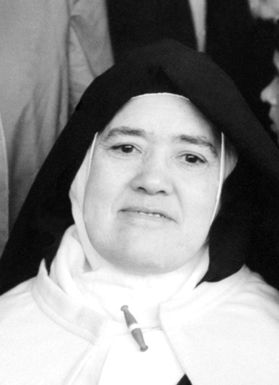 |
||
In 1967, no one thought to question whether these two photos were of the same person. They seemed similar enough. |
(Left) Sr. Lucia in
1946. Is this the same person as the 1967 "Sr. Lucia"? |
|
With this danger clearly in mind, we intend to give a well-balanced view of the photographic evidence, together with scientific opinion on the subject of facial aging.
The reasoning behind the theory runs thus: Sr. Lucia was a Dorothean nun when she revealed the first two Secrets, together with the existence of the Third. Some years later, in 1948, she obtained permission to practice her religious life in a strict cloister. She was sent to the Carmel of Coimbra, where, naturally enough, she was seldom photographed. She did not emerge into public view until 1967, at the celebrations for the 50th Anniversary of the apparitions. Then she appears somewhat different from the photos of her taken only 20 to 25 years previously. But no one noticed this, because the older photos were practically unknown—only photos of her as a young girl at the time of the apparitions had been widely distributed. So the thinking is that a switch was made to avoid conflict over the Third Secret, presumably in the early 1960';s. There have been claims that the real Sr. Lucia died—even that she was murdered—around the year 1960, but there has been no substantial evidence to back up those claims. So we will examine here only the theory that there were two Sr. Lucias: a pre-1960 "Sr. Lucia I" and a post-1960 "Sr. Lucia II."
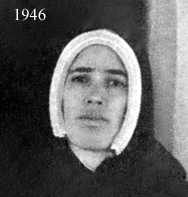 We begin with the short
verbal description of Sr. Lucia's appearance, made by the author William Thomas Walsh
after he had interviewed Sr. Lucia in 1946: "[Lucia's teeth] were large, projecting and irregular, causing the
upper lip to protrude and the heavy lower one to hang, while the tip of her snub nose
turned up more than ever. Sometimes her swarthy face suggested a nature that could be
sullen, stubborn and defiant, if not perverse. But the appearance was deceptive, for under
the stimulus of any emotion, the light brown eyes could flash or twinkle, and the little
dimples that creased her cheeks when she smiled contributed to an expression quite
charming." (Our Lady of Fatima, p. 11)
We begin with the short
verbal description of Sr. Lucia's appearance, made by the author William Thomas Walsh
after he had interviewed Sr. Lucia in 1946: "[Lucia's teeth] were large, projecting and irregular, causing the
upper lip to protrude and the heavy lower one to hang, while the tip of her snub nose
turned up more than ever. Sometimes her swarthy face suggested a nature that could be
sullen, stubborn and defiant, if not perverse. But the appearance was deceptive, for under
the stimulus of any emotion, the light brown eyes could flash or twinkle, and the little
dimples that creased her cheeks when she smiled contributed to an expression quite
charming." (Our Lady of Fatima, p. 11)
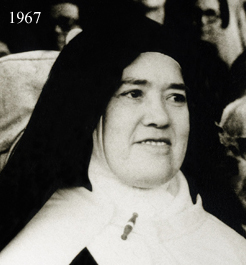 Next we have the points of difference
noticed in an article (The Two Lucys—Photos and Facts) by Dr. Marian T.
Horvat, which we have extracted and numbered, so that they may more easily be compared
with scientific comment. We are omitting several points which appear to be too subjective.
To be perfectly fair we are also omitting nearly all the photos provided by Dr. Horvat,
which compare the 1946 Sr. Lucia with the "Sr. Lucia" of advanced age only, not
the 1967 photos. We do provide photos from the official Fatima website (it is not known,
however, whether any of these photos have been altered).
Next we have the points of difference
noticed in an article (The Two Lucys—Photos and Facts) by Dr. Marian T.
Horvat, which we have extracted and numbered, so that they may more easily be compared
with scientific comment. We are omitting several points which appear to be too subjective.
To be perfectly fair we are also omitting nearly all the photos provided by Dr. Horvat,
which compare the 1946 Sr. Lucia with the "Sr. Lucia" of advanced age only, not
the 1967 photos. We do provide photos from the official Fatima website (it is not known,
however, whether any of these photos have been altered).
1) "The natural line of the thick, heavy eyebrows of Sister Lucy I is straight. The brows extend into the forehead area above her nose and past the inner corner of her eyes. The eyebrows of Sister Lucy II... are not straight, but slightly arched and taper off; the arch begins directly over the eye. There is a broad space without brows above the nose between the two eyebrows."
2) "When Sister Lucy I smiles, her upper cheeks appear like two small round apples. Although the cheeks of Sister Lucy II are partially covered by her large glasses, it seems clear she lacks these bulges."
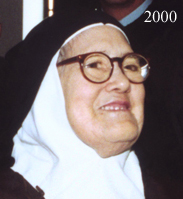 3) "I could not find any photo of
Sister Lucy I, smiling or serious, with her nostrils open. They do not flare naturally.
All the photos of Sister Lucy II, however, show her with her nostrils flaring. They open
naturally"
3) "I could not find any photo of
Sister Lucy I, smiling or serious, with her nostrils open. They do not flare naturally.
All the photos of Sister Lucy II, however, show her with her nostrils flaring. They open
naturally"
4) "Under the apple cheeks of Sister Lucy I are definite dimple creases... But the cheeks of Sister Lucy II are flat and broad, with no creases or dimples when she smiles."
5) "In his description of Sister Lucy, Walsh also notes her protruding upper lip and 'heavy lower one' that hangs. The two lips have different widths. The lips of Sister Lucy II, however, are flat, thin, tight and of an equal width."
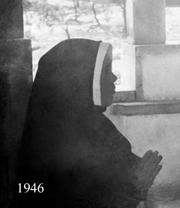 6) "When Sister Lucy I smiles, the ends of her mouth point upward. But when Sister
Lucy II smiles, the ends of her mouth point downward."
6) "When Sister Lucy I smiles, the ends of her mouth point upward. But when Sister
Lucy II smiles, the ends of her mouth point downward."
7) "Another distinguishing feature of Lucy as a child that can be seen in her photos up to age 40 is a protuberant muscle in the middle of her chin, pronounced enough to form a dimpled area underneath. But this muscle never appears in the photos of Sister Lucy II."
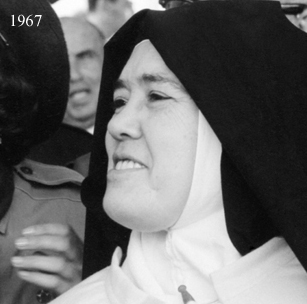 8) "Sister Lucy I's chin is
strong but not salient. On the contrary, the chin of Sister Lucy II is a prominent chin.
The latter has a square jaw, which does not appear in the photos of Sister Lucy I—
The chin of Sister Lucy I, even though she is younger and not overweight, recedes sharply
into her neck, with the tendency to disappear into a double-chin. However, the chin of
Sister Lucy II, although she is older and heavier, juts forward and outward. It is so
prominent that it forms a kind of platform extending out further than her nose." That
it really extends further than the nose does not appear to be true of all the photos, such
as that on the right.
8) "Sister Lucy I's chin is
strong but not salient. On the contrary, the chin of Sister Lucy II is a prominent chin.
The latter has a square jaw, which does not appear in the photos of Sister Lucy I—
The chin of Sister Lucy I, even though she is younger and not overweight, recedes sharply
into her neck, with the tendency to disappear into a double-chin. However, the chin of
Sister Lucy II, although she is older and heavier, juts forward and outward. It is so
prominent that it forms a kind of platform extending out further than her nose." That
it really extends further than the nose does not appear to be true of all the photos, such
as that on the right.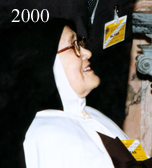
9) "...the profile of her (Sister Lucy I's) nose... aptly fits the description of Walsh, who noted that 'the tip of her snub nose turned up.' However, the nose of Sister Lucy II is rounded at the tip, pointing slightly downward."
10) "Sister Lucy I has very long and bad teeth... It is not indisputable that Sister Lucy II is wearing dentures... No one replaces bad and ugly teeth by anther set of bad and ugly teeth... In addition, since dentures are artificial, they never change their appearance. But at times Sister Lucy II's gums seem inflamed... at other times her gums seem to retract... And if these are the natural teeth of Sister Lucy II, then they are clearly different from the natural teeth of Sister Lucy I. In that case, how can it be explained except that we are looking at two different persons?" Dr. Horvat did not include a 1967 photo, as we do below. There the 1967 photo (middle) shows nearly perfect teeth.
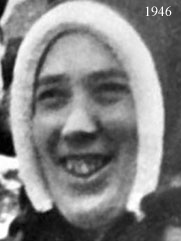 |
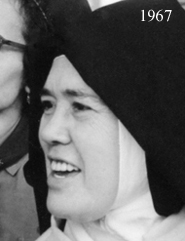 |
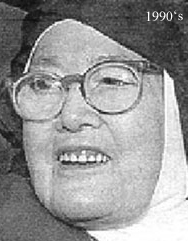 |
Long, bad teeth; perfect teeth; short, bad teeth. The center and right photos can perhaps be accounted for if they are of natural teeth, shortening with age and affected by gum disease. But then, how explain the teeth on the left? |
||
Now we look at scientific opinion, extracted from an article by FBI agents Michael A. Taister and Sandra D. Holliday and Forensic Odontologist H.I.M. Borman (Comments on Facial Aging in Law Enforcement Investigation, Forensic Science Communications, April 2000, Vol. 2, No. 2). We will include numbers to reference the extracts numbered above. Wrinkling of the skin is not an issue here.
"Evidence of biological aging usually appears between the ages of twenty and thirty... Lines around the mouth... become apparent, and lines from the edge of the nose to the lateral part of the mouth will progressively deepen. With the onset of these changes there may also be a hollowing of the cheek area below the... cheekbone...(2, 4, 6) Men and women of middle age may display thicker, bushier eyebrows than in their younger years... (1—the opposite is seen in the photos.)
"More general age-related trends affecting the appearance and profile of the face include the increasing prominence of the chin (8), the decreasing convexity of the skeletal nose (9), and the lengthening of the upper and lower lips (5). These trends are particularly evident from birth until age eighteen, but their effects are seen, though less dramatically, into adulthood and beyond. With increasing age, the skeletal profile of the human face begins to lose its distinctive, protuberant appearance as changes in the shape and orientation of the nasal bone lead to a flattening of the facial features (2, 3, 4, 6, 7). At the same time, however, the soft tissue facial profile trends towards greater convexity with progressive age, demonstrating that the musculature and skin of the head and face do not always follow the development of the underlying bony tissue (1, 2, 4, 7).
"When a person loses teeth... the demand for support in the bone surrounding the teeth will be decreased. This leads to a resorption of bone in those areas of disuse... The presence of less bony tissue in the upper jaw decreases the height of the face and causes the lower jaw to appear more prominent (8).
"Replacement of the natural teeth with dentures may inhibit the continued resorption of bone in the upper and lower jaws to some extent, but a change in the density if not the physical thickness of the bone tissue in the jaws will usually be apparent."
Women will tell us that eyebrows thin with advanced age (1) and that lips lose their pucker (5). So given all of the above, it seems that nearly all of the differences noted by Dr. Horvat could possibly be accounted for by aging. Although it must be admitted that the difference in the chin and jaw between 1946 and 2000 is very pronounced, this could also be accounted for by differences in posture. The earlier photos showing a receding chin may be due to the head and neck being held back, in a more youthful attempt at "good posture." If the head were also slightly bent down, the chin would also be drawn back somewhat. In the later pictures, the head and neck may be slouching forward, with the head tilted up, thus tending to jut the chin out.
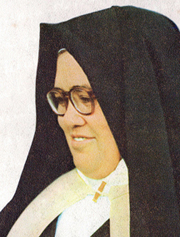 The image on the right
shows the cover of a book published in 1976 (Fatima in Lucia's Own Words); but
the cover photo was supposed to have been taken in 1963. Here Sr. Lucia is somewhat obese
and wears glasses. Her head is bent slightly down, so her chin does not jut out. Her teeth
appear to be straight, but this is far from clear. It is quite possible that she was asked
to lose weight and forego wearing her glasses for the public appearance in 1967. There are
definitely differences between this and the 1967 photos, but they do not seem conclusive.
The image on the right
shows the cover of a book published in 1976 (Fatima in Lucia's Own Words); but
the cover photo was supposed to have been taken in 1963. Here Sr. Lucia is somewhat obese
and wears glasses. Her head is bent slightly down, so her chin does not jut out. Her teeth
appear to be straight, but this is far from clear. It is quite possible that she was asked
to lose weight and forego wearing her glasses for the public appearance in 1967. There are
definitely differences between this and the 1967 photos, but they do not seem conclusive.
The indisputable difference is the teeth. What possible scenario can account for the dental differences, not just between the 1946 and 1967 photos, but also between both of them and the circa 2000 photos? We here examine a few:
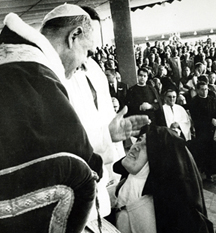 Scenario 1: Sr. Lucia had her bad
teeth fixed with major dental surgery or complete dentures before 1967. This might
also explain other facial differences, like the chin and jaw. But then how do we explain
the short teeth and gum problems of the later photos? Did she have her first, nice
dentures replaced with bad ones? If she did not receive full dentures, but only partials
or crowns, could her teeth end up looking as they do in the circa 2000 photos—evenly
worn?
Scenario 1: Sr. Lucia had her bad
teeth fixed with major dental surgery or complete dentures before 1967. This might
also explain other facial differences, like the chin and jaw. But then how do we explain
the short teeth and gum problems of the later photos? Did she have her first, nice
dentures replaced with bad ones? If she did not receive full dentures, but only partials
or crowns, could her teeth end up looking as they do in the circa 2000 photos—evenly
worn?
Scenario 2: Sr. Lucia of 1967 is the same person as 1946, but not the same as 2000. This is highly unlikely, since the 1967 Sr. Lucia is closer in appearance to the 2000 Sr. Lucia.
Scenario 3: Sr. Lucia of 1967 and of 2000 are the same person, with natural teeth, which were worn with age and affected by gum disease. But then the long, crooked teeth of Sr. Lucia of 1946 must be explained. That she had those long, crooked teeth straightened with braces and filed to make them even would explain it. But why? Would a cloistered nun really have cosmetic dental work done?
Scenario 4: They are two different sets of teeth, because they are two different people. How could the real Sister Lucia, who saw Hell, go along with the Vatican II cover-up of Our Lady's Secret?
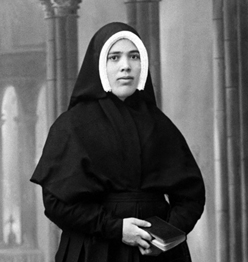
Contact us: smr@salvemariaregina.info
Visit also: www.marienfried.com